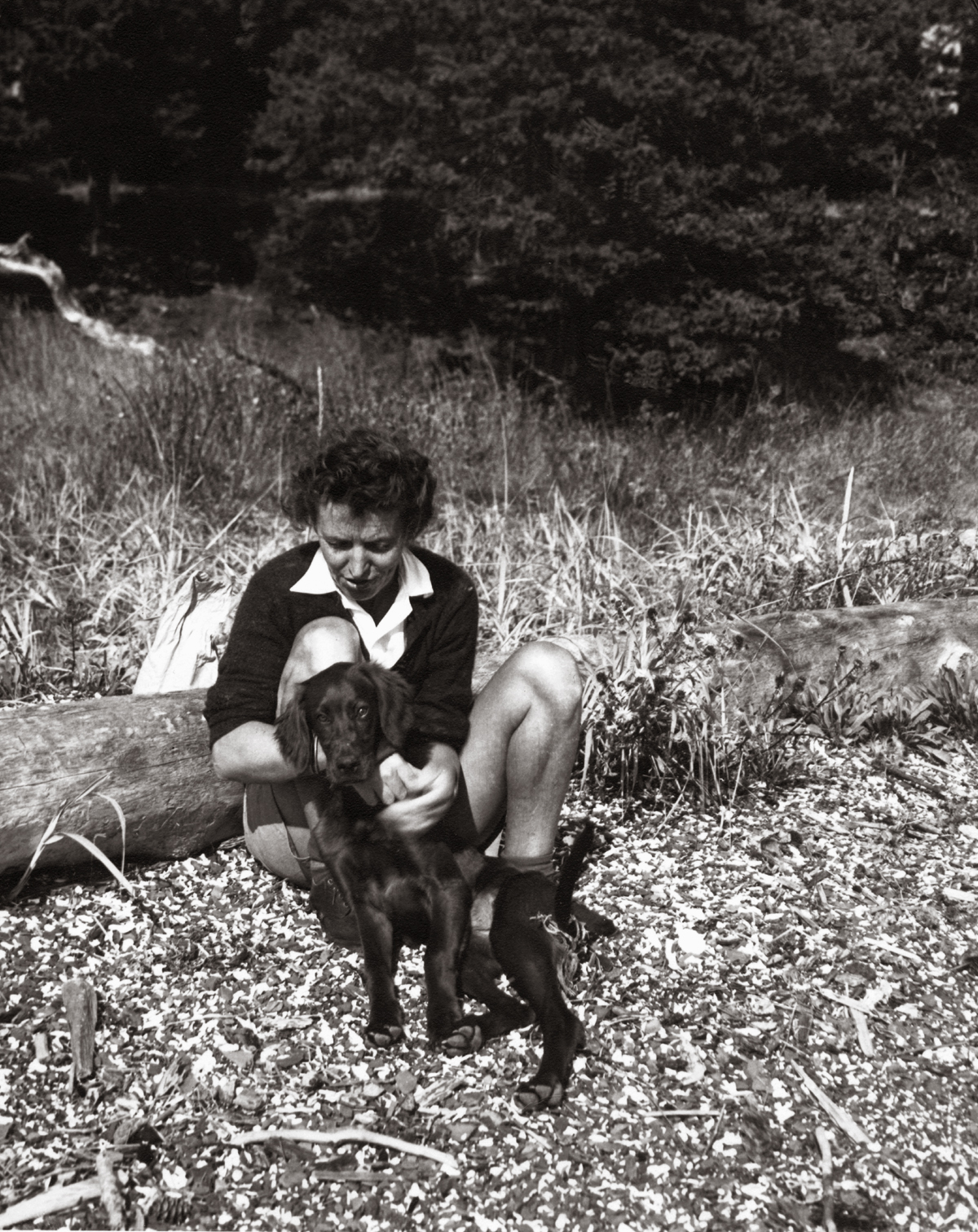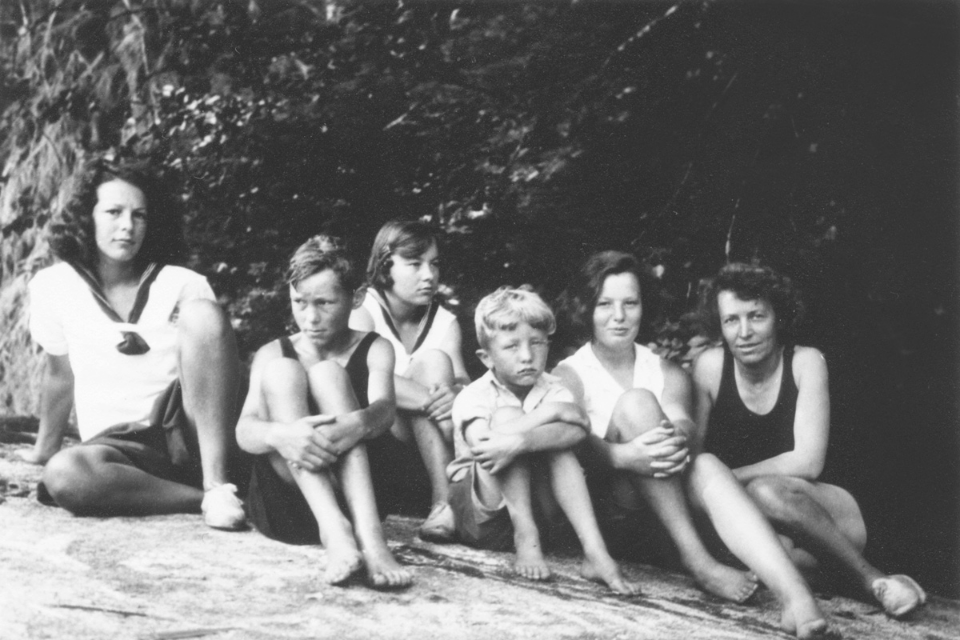- Following The Curve of Time: The Untold Story of Capi Blanchet
- Touchwood (2018)
“We dropped anchor between a small island and a great rugged cliff topped with moss-laden firs that bounded one end of the beach. Then we piled into the dinghy and rowed ashore. The place was deserted — for it is a winter village, and every summer the tribe goes off for the fishing. So, when we landed, no chief came down with greetings, no one sang the song of welcome, only a great black wooden figure, standing waist high in the nettles up on the bank, welcomed us with outstretched arms.”
Passages like this have made a place for Muriel Wylie “Capi” Blanchet’s 1961 book The Curve of Time on countless bookshelves, from Victoria to Prince Rupert, and especially those of boaters. It’s a classic of B.C. literature, describing the summers in the 1920s and ‘30s when she put her five children aboard a 25-foot boat, the Caprice, and explored the inlets and islands of a deserted coast.
Blanchet’s book is heavily fictionalized, and her own children rolled their eyes at many parts. One of her sons listened to a sister reading a chapter and said, “Well, she got that part right.” But, Converse tells us, he never read the whole thing.
Still, she evokes a time when a handful of recreational boaters and homesteaders seemed to have the coast almost to themselves, and the time before that when the Indigenous peoples held it all.
Who was she, and how had she come to be the single mother of five kids living in a small house outside Victoria almost a century ago? Capi Blanchet herself offered only the barest outline of her background, but Cathy Converse’s biography (newly updated from the 2008 first edition) offers enlightening details. It also gives us a portrait of a strikingly independent woman.
Blanchet was born in Montreal in 1891 to a prosperous anglophone business family, the Liffitons. Growing up, Muriel (a name she hated) received a solid classical education while also acquiring a love of the natural world on long summer holidays. She was expected to go on to university, but instead she married the handsome and intelligent brother of a classmate, Geoffrey Blanchet.
The young couple settled down to domesticity — he as a bank manager for the Bank of Commerce (later to become CIBC), she as the mother of four children born between 1913 and 1919. But Geoffrey succumbed to depression as the result of a stressful work incident — unmasking a friend as an embezzler — and took an indefinite leave of absence.
Rather than stay put in Toronto, the Blanchets decided to move west to British Columbia, where living costs were lower — driving there in 1922 long before modern highways. They bought a “Little House” on Curteis Point, not far south of today’s Swartz Bay ferry terminal but then a secluded rural area.
How to clean a boat engine
The Blanchets may have wanted to economize, but they liked the boating culture of their new home and soon bought Caprice for $600 — the equivalent of $8,700 in today’s dollars. The boat had sunk the winter before and then been raised; it would need a lot of work. Geoffrey Blanchet was no mechanic, but Capi (who took her nickname from the boat) took the engine apart, cleaned it, and put it back together. It would serve her for many years.
After a failed attempt to get back to work, Geoffrey returned to Curteis Point in 1926, weak and depressed. One September day he took Caprice alone on a trip to Saltspring Island, and vanished. The boat was found empty off Knapp Island, with Geoffrey’s clothes on board. He was presumed to have gone for a swim and suffered a heart attack.

Capi, now 35 and the mother of a fifth child, refused to take her family back east. They remained in the Little House and she eked out her modest income by renting it in the summers and taking her family on the coastal cruises she would later chronicle in The Curve of Time.
As Converse notes, Capi Blanchet was not the only woman to pilot boats along the coast. But most did so as spouses of fishermen or as daughters racing their affluent families’ yachts. Capi cruised the coast because she wanted to, and to earn a little money from her summer rentals. She didn’t care what others thought, including the men who were impressed with both her handling of Caprice and her shorts.
Lost on the curve of time
In her journeys, Blanchet evidently gained a keen sense of the coast not just as a place but as a presence — an environment both beautiful and dangerous, where entering a channel at the wrong time could be fatal, but traversing it properly offered access to extraordinary inlets and islands containing the remnants of once-great Indigenous communities. She and her children sometimes encountered bentwood-box coffins suspended from cedars or standing on rocky islets. Her vivid descriptions of such incidents make us wonder where we are on the curve of time: now, or in the 1920s, or long before?
By blending trips and fictionalizing some of them, Blanchet also set a test for future boaters: could they identify all the places and communities she described? Converse helps identify many of them, and also offers updates on their present condition. One community, Ba’a’s, in Blunden Harbour, was the subject of a painting by Emily Carr, and some of its residents were actors and costume designers for Edward Curtis’s 1914 movie In the Land of the War Canoes.
But 50 years later, in 1964, the Department of Indian Affairs moved the ’Nak’waxda'xw people from Blunden Harbour to Port Hardy, promising jobs, good housing and schools. The promises were broken, and then they themselves as well: “The rhythm of the community was fractured, cultural cohesiveness thrown on the pyre of government paternalism and expediency.”
Converse describes how Blanchet wrote about her cruises in the 1950s, first as articles and then as a book published in Britain in 1961. It did not sell especially well, and six months later, while working on a sequel, Blanchet died at her typewriter of a cerebral hemorrhage. Not until 1968 would a friend and neighbour, Gray Campbell, bring out in a Canadian edition that has become an always-in-print classic. Cathy Converse has given us a welcome commentary on Capi Blanchet and her world, one that enriches our understanding of both. ![]()
Read more: Environment
















Tyee Commenting Guidelines
Comments that violate guidelines risk being deleted, and violations may result in a temporary or permanent user ban. Maintain the spirit of good conversation to stay in the discussion.
*Please note The Tyee is not a forum for spreading misinformation about COVID-19, denying its existence or minimizing its risk to public health.
Do:
Do not: